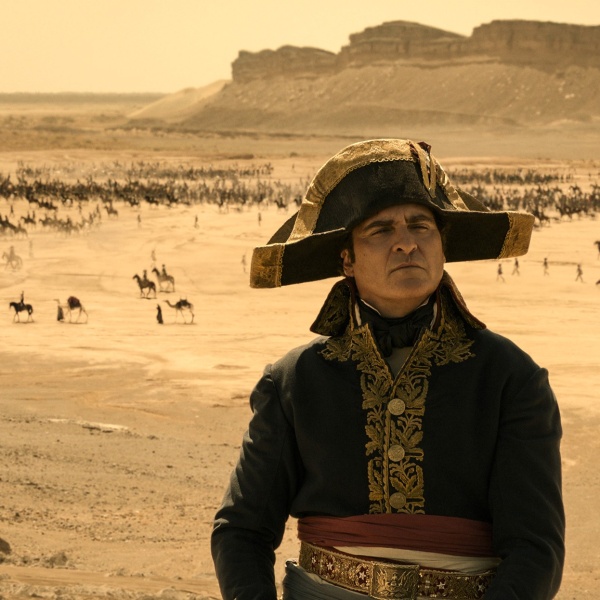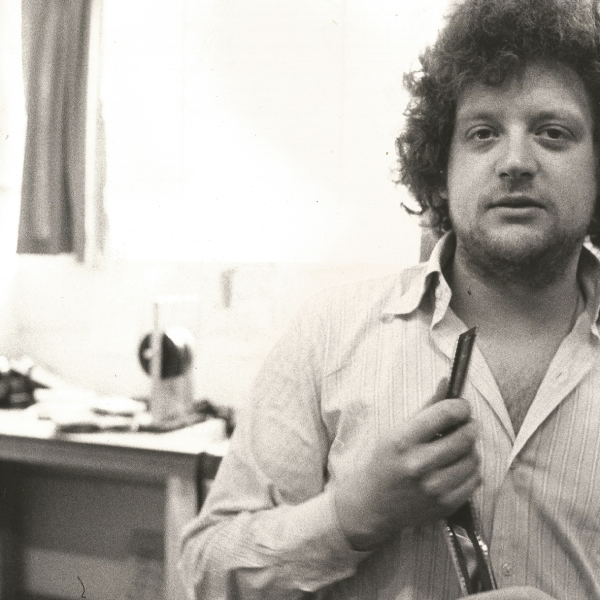
A leaf twirls through a pair of Black fingers. A deck of playing cards is bridged together in extreme close-up. A dry-cleaned suit hangs out the window of a parked car like it’s waiting for its body to come back. A boy named Elwood studies his reflection in his grandmother’s steaming iron, and later in the window display of the local Tallahassee electronic shop whose TVs are broadcasting a speech by Martin Luther King, Jr. The year is 1962, Jim Crow laws are still in full effect across the South, and young Elwood Curtis (Ethan Herisse) can’t help but see himself in the world around him — he can’t help but think he can change it.
In the news, Elwood sees men shooting themselves into outer space. At home, Elwood sees his defiantly ebullient Nana (Aunjanue Ellis-Taylor) dance around the kitchen as if nothing here on Earth could take the song out of her step. At school, Elwood sees pencils stuck in the ceiling of his classroom, where his teacher has the students cross out the most damaging lies from their history textbooks, and encourages Elwood to attend a free college for high-achieving Black kids. While hitchhiking there on the kindness of strangers, Elwood sees the man behind the wheel begin to panic when a cop pulls them over. The car was stolen. “Look down,” the driver tells him, but Elwood doesn’t. He needs to see this too. And that means we do as well, because in RaMell Ross’ faithful but visionary adaptation of “The Nickel Boys” (for which Colson Whitehead won the 2020 Pulitzer Prize for Fiction), the story is almost exclusively told through the eyes of its two lead characters.
Elwood is one, and Turner (Brandon Wilson) is the other. They meet at Nickel Academy, the barbaric reform school where Elwood is forced to serve his time after his arrest. Elwood watches intently as the cold-blooded school master (Hamish Linklater) lectures the “grubs” about how they can earn their freedom, but Turner knows the system is rigged against them. He’s been at Nickel before, and he doesn’t have any motivation to leave. (“Out there and in here, it’s the same,” he says). Dozens of Black boys are buried in the yard behind the shed where the school master beats them at night, and Turner has resigned himself to joining them at some point (the film’s violence is largely abstracted, the suffering of its Black bodies less a spectacle than a system at work). Elwood still believes in America’s potential, while Turner is convinced that our country is already — and has always been — fulfilling the original promise of its cruelty.
Ross’ formal conceit quite literally forces us to see both perspectives, but the soft poetry of his pointillistic approach — his focus on what the director refers to as “the epic banal” — disabuses that philosophical difference of any and all traces of didacticism. Pure sense and subjectivity in a way that evokes the same visual magic of Ross’ documentary work, “Nickel Boys” so viscerally and fundamentally centers the experience of its young Black characters that even the most racist brand of revisionist history could never hope to deny their truth.
In its way, and in the context of a mainstream film that Amazon MGM Studios will release into hundreds or thousands of theaters across the United States, Ross’ aesthetic is as radical as Whitehead’s reimagining of the Underground Railroad as an actual train line. It’s also every inch as successful. Collaborating with the brilliant cinematographer Jomo Fray (“All Dirt Roads Taste of Salt”), who shares his prismatic attention to detail, Ross has devised an astoundingly effective way to express the relationship between how we see things and what we glean from them. The result is a rare testament to the transformative potential of cinematic adaptation (Ross co-wrote the script with Joslyn Barnes), and a staggeringly beautiful reminder that America’s most enduring narratives are only subject to change when people are invited to look at them in a different light. (“Cell phones didn’t allow a new kind of violence,” Ross says in the film’s press notes, “but an uptick in witnessing”).
The effect is by turns both distancing and immersive. During the first chapter of the film, the impressionistic splendor of Fray’s camerawork seems as if it might be an end unto itself, and it’s hard to fathom how Elwood will become anything more than a disembodied avatar for the absent poetics of the era’s Black imagery; archival materials, shot with the clinical lifelessness of crime scene photographs, help underscore how transformative it is to reconcile this bleak chapter of African American history with the missing tactility that allowed it go unwritten for so long.
But Turner’s introduction has as profound an effect on the film as it does on Elwood himself, not only because it finally enables us to engage with Elwood as a character in his own right (his face looks so much sadder than we imagined when looking out from it), but also because switching back and forth between Elwood and Turner’s perspectives constantly forces us to scan the frame for context clues as to which character we’re “with” at that moment.
“No one else is gonna get you out of here,” the cynical Turner tells his wide-eyed new friend, but there isn’t a scene that goes by without us looking to other people for help. These boys have been abandoned to a penal colony so dehumanizing that nobody even registers when they disappear; it’s only because of each other that any of them know who they are, an unspoken bond that Ross’ conceit literalizes for us without any emotional handwringing whatsoever. And the seamlessness of that conceit’s execution — made possible with a variety of bespoke camera rigs that create the illusion of subjectivity without perfectly emulating the human eye or risking the stilted gimmickry of a first-person video game — allows scenes to feel immediate and conceptual all at once.
One unforgettable instance from the many that have stuck in my mind: Nana visits Nickel Academy, where she’s denied the chance to see Elwood. Accepting Turner as the next best thing, she begs him for a hug, the camera pressing deeper into the fabric of her dress until the entire screen is just a blur. It’s as bluntly sentimental a beat as any in the film, a desperate grandmother embracing a boy without any family of his own, but the raw emotionality of it is textured with — not undercut by — the illusion-breaking artifice of how it’s shot.
In the span of a single moment, the pain these characters have been so unfairly portioned is rendered parallel to its own artistic construction, as the immediacy of their circumstances is galvanized by the historical act of reimagining them, and vice-versa. The camerawork emphasizes the raw honesty of the cast’s performances, and the cast’s performances guide the virtuosity of the camerawork.
“Nickel Boys” is full of such revelatory fragments, many of them joyful and most of them as light and elusive as a memory. The sense of discovery they engender prevents the movie from growing numb to its own aesthetic (crucial to an episodic narrative that’s less sustained by action than it is by the momentum of its own searching curiosity). So too does the film’s persistent feeling of being simultaneously both lived and remembered. In its truth and its telling alike, this story is past and present at the same, a dynamic that Ross hammers home with a smattering of flash-forwards — filmed entirely from behind Daveed Diggs’ head — that add a heartbreaking new dimension to the camera’s POV-based mandate. To some filmmakers, the final pages of Whitehead’s novel might have made the whole book unadaptable. To Ross, they seem to have been the reason why the book had to be adapted.
It’s worth noting that the Dozier School for Boys, on which Nickel Academy is based, was only closed down in 2011. And while “Nickel Boys” is mercifully far too experiential and self-possessed to end with a series of sobering title cards about the history it depicts, there’s a palpable sense of implication in the recurring use of film clips (Stanley Kramer’s “The Defiant Ones” is a major point of reference) and news footage, which serve as damning reminders of culture’s selective myopia. So does the glitchy recursiveness of Alex Somers’ and Scott Alario’s unusual score, as its looping tones and squelches double time back on itself until Elwood, Turner, and all that they experienced both alone and together begin to churn into a shared essence of survival.
These two boys, so different in their outlooks but so complementary in their dreams, elegantly come to embody the historic disconnect between what is and what can be — and the eternal struggle to reconcile those realities within ourselves. Light on its feet and soft as a velvet hammer, “Nickel Boys” mourns the stolen potential of its characters while rescuing a profound resilience from how they come to see themselves in each other (a synthesis crystallized in the film’s casually stunning final minutes, which force us to look at this story in a whole new light just as it ushers us out of the darkness).
“The record went round and around like an argument that always returned to its unassailable premise,” Whitehead wrote of “Martin Luther King at Zion Hill.” It’s the only vinyl that Elwood owns before his abduction, and he listens to it more times than he could count. To watch Ross’ “Nickel Boys” — as major and memorable an achievement as any American film this decade — is to understand what Elwood is hoping to hear: It’s not the message of Dr. King’s words, which already resonate throughout every part of his being, but rather the invitation to speak them in his own voice. To hear them come out of his own mouth, and see the future they envision through his own eyes. Not as ideals, but as actions. Not as history, but as purpose. The dream was always beautiful, but only through his friendship with Turner, which refracts all of the boys’ hope and heartache into a resilience that neither of them could sustain on their own, will that dream ever become real enough to touch. How fitting the film ends with the camera staring up at an outstretched hand, imploring us to grab it.
Grade: A
“Nickel Boys” premiered at the 2024 Telluride Film Festival. Amazon MGM Studios will release it in theaters on Friday, October 25.
Want to stay up to date on IndieWire’s film reviews and critical thoughts? Subscribe here to our newly launched newsletter, In Review by David Ehrlich, in which our Chief Film Critic and Head Reviews Editor rounds up the best reviews, streaming picks, and offers some new musings, all only available to subscribers.




